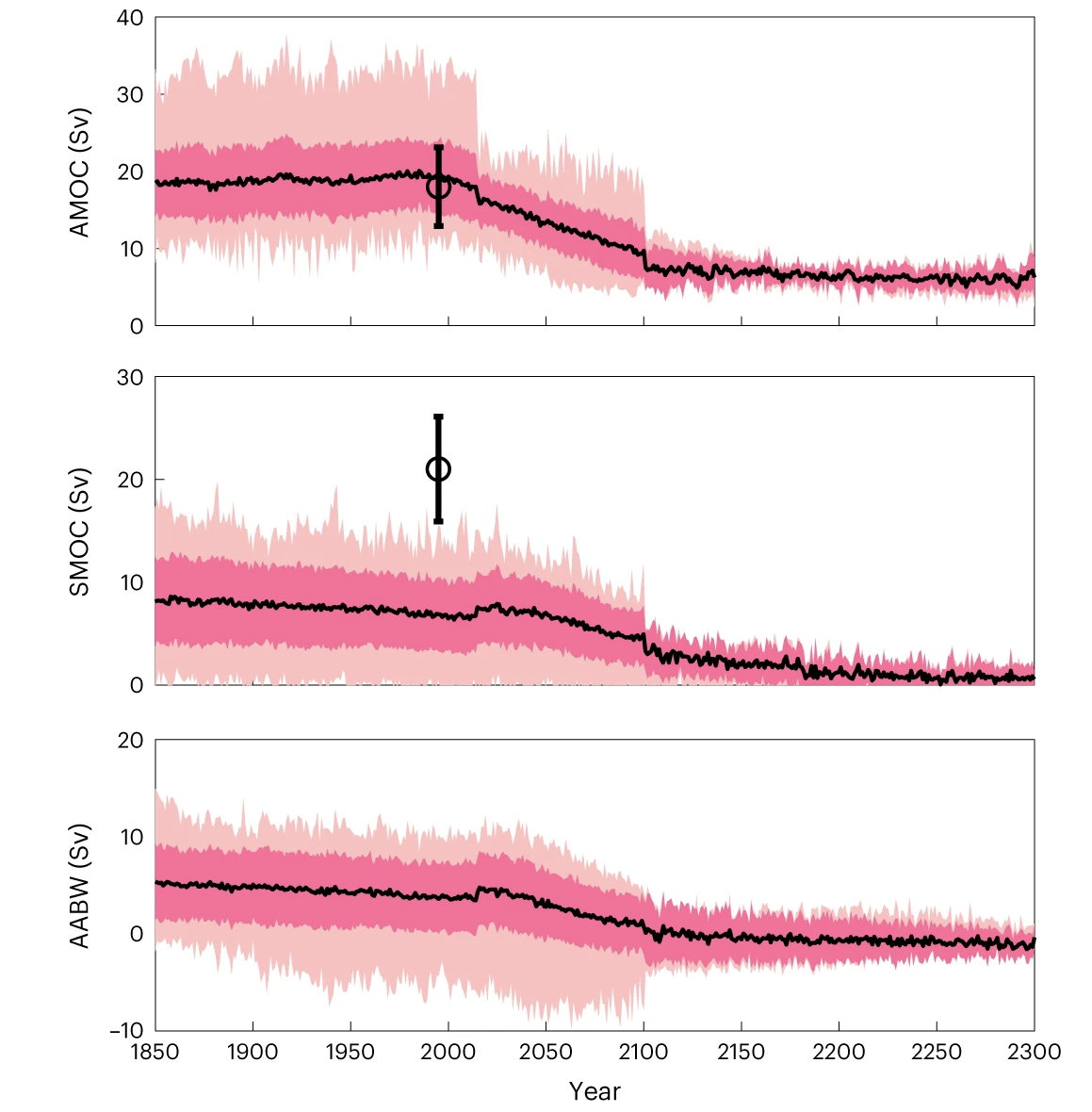Reduced CO2 Uptake and Growing Nutrient Sequestration from Slowing Overturning Circulation
Slowing deep ocean circulation will be a positive feedback for climate warming and could decimate marine ecosystems on multicentury timescales.
The Science
The global Meridional Overturning Circulation (MOC), comprised of the Atlantic-based upper MOC cell (AMOC) and the deeper Southern MOC cell (SMOC), strongly impacts climate and marine biogeochemistry. Earth System Models (ESM) from the Coupled Model Intercomparison Project phase 6 (CMIP6) project rapidly declining AMOC rates over the twenty-first century (Fig. 1). Recent observations suggest declining North Atlantic Deep Water (NADW) formation and slowing of AMOC are underway and already impacting biological productivity.
This study examined output from a suite of thirty-six CMIP6 models to quantify the impacts of climate warming on deep ocean circulation, as reflected in the overturning rates of the AMOC and the SMOC. The research then investigated how climate-driven slowing of both MOCs impacts ocean anthropogenic CO2 uptake, and the ocean distributions of carbon and the key nutrients nitrate and phosphate.
The oceans play a critical role in removing anthropogenic CO2 from the atmosphere. Global ocean dissolved inorganic carbon (DIC) concentrations have increased over time as the oceans take up anthropogenic CO2, driven by rising atmospheric CO2 concentrations. Both the biological and solubility carbon pumps contribute to ocean CO2 sequestration. The solubility pump refers to the combined influences of ocean circulation and inorganic carbon chemistry that contribute to the uptake and storage of carbon dioxide, helping maintain observed vertical gradients of DIC (higher concentrations at depth). The biological pump refers to the biogenic export of carbon to the interior ocean (as sinking particulate organic carbon (POC), sinking calcium carbonate (CaCO3), and transported dissolved organic matter), which modifies surface carbon chemistry and air–sea CO2 exchange.

Figure 1. Mean MOC rates (Sv) under the SSP5–8.5 scenario from CMIP6 models to year 2300 (36 models for historical period, 28 extend to 2100, 6 models extend to 2300) are shown for AMOC (top) and SMOC (middle). Black line indicates the CMIP6 multi-model mean, and light and dark pink shadings indicate the range and one standard deviation. Black circles and lines indicate mean and one standard deviation of the observation-based MOC estimates. Also shown is the mean northward bottom flow across 50° S (>4,000 m), representing export of Antarctic Bottom Water (AABW) from the Southern Ocean (see paper for details).
The Impact
The study shows (Fig. 1) that there is a drastic reduction in both overturning cells with climate warming, even under the moderate-warming CMIP6 SSP1-2.6 scenario (the latter is not shown in the figure, see paper for details). The slowing deep circulation weakens the uptake of anthropogenic CO2 by the ocean solubility pump, proving a positive feedback, that could extend or intensify peak-warmth climate conditions. The reduced uptake by the solubility pump is partially compensated by a more efficient biological pump, that transfers carbon and nutrients to the deep ocean. On multi-century timescales this will increasingly sequester nutrients in the deep ocean, leading to declining global-scale net primary production (NPP). The Integrated Assessment Models (IAMS) used to generate the CMIP6 climate scenarios likely overestimated ocean CO2 uptake by not properly accounting for the slowing deep circulation. Thus, emissions reduction goals for climate stabilization may need to be revised.
Summary
The ocean biological pump which causes organic matter sinking from surface waters to decompose in the interior ocean, acts to move carbon and key nutrients from the surface to the deep ocean. The deep circulation must eventually return these exported nutrients to the surface to maintain biological productivity. The study demonstrates that climate-driven slowing of the deep circulation weakens this return flow to the surface, allowing nutrients to increasingly accumulate in the deep ocean. The slowing circulation also decreases the transport of absorbed anthropogenic CO2 into the deeper ocean, weakening the ocean’s capacity to remove anthropogenic CO2 from the atmosphere, providing a positive feedback for climate warming.
Publication
- Liu, Yi, Jefferson Keith Moore, Francois Primeau, and Weilei Wang. 2023. “Reduced Co2 Uptake And Growing Nutrient Sequestration From Slowing Overturning Circulation”. Nature Climate Change 13: 83-90. doi:10.1038/s41558-022-01555-7.
Funding
- This work was supported by the Earth System Model Development program area of the Department of Energy, Office of Science, Biological and Environmental Research program.
Contact
- Jefferson Keith Moore, University of California Irvine
This article is a part of the E3SM “Floating Points” Newsletter, to read the full Newsletter check:



